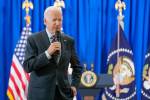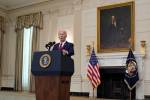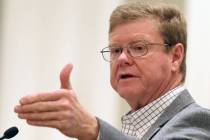NPRI: Expanding Medicaid not a good call for Nevada

CARSON CITY – Nevada does not have enough doctors willing to take new Medicaid patients, so it makes no sense for Gov. Brian Sandoval to expand the program, a top analyst with a Las Vegas-based conservative organization argues.
Geoff Lawrence, deputy director of policy for the Nevada Policy Research Institute, said Tuesday that a 2008 study by the Center for Studying Health Care System Change showed that only 40 percent of physicians in the United States accept all new Medicaid patients.
“Advocates of expansion regularly oversimplify the issue,” Lawrence said. “They assume that loosening eligibility requirements so that more individuals qualify for Medicaid would translate directly into more low-income families getting greater access to qualify health care. That would be true only if Medicaid eligibility really translated into people having access to quality health care. In truth, health care providers are turning away Medicaid patients at ever-higher rates.”
But Mike Willden, director of the state Department of Health and Human Services, said his department generally has been able to find Nevada doctors willing to take Medicaid patients, though some complain about low reimbursement rates.
In 2008, his agency surveyed 605 medical providers in Nevada and found 93 percent took Medicaid patients and
88 percent said they would take new Medicaid patients.
He said if the federal Patient Protection and Affordable Care Act is fully implemented in Nevada, an option Sandoval has, nearly 300,000 more people in the state would turn to Medicaid – the health care program for the poor, the disabled and some of the elderly – or buy private health insurance through the new Silver State Health Insurance Exchange.
“That will put additional stress on our primary care system,” Willden said. “We don’t have the tools to measure what will happen. We need to graduate more doctors.”
Members of the Southern Nevada Medical Industry Coalition on Thursday called on Sandoval to expand the Medicaid program to include 71,000 people who earn just more than poverty-level wages. In October, 313,415 Nevadans already received Medicaid.
Sandoval said last week he would not make a decision on expanding Medicaid until just before he releases the state’s proposed 2013-15 budget on Jan. 16.
Under the Patient Protection and Affordable Care Act, about 16 million more Americans would be eligible for Medicaid if their home states agree to expand the program. This part of the law goes into effect in 2014.
In upholding the Obamacare law in June, the U.S. Supreme Court ruled it is up to the states to decide whether to expand Medicaid.
Sandoval could reject expansion, but the state Legislature might try to override his decision.
Supporters of expansion contend that Nevada would receive $300 million more in federal funding a year and that its costs might be as low as $30 million. The Sandoval administration has not yet released what it thinks are the actual costs the state would have to absorb.
Lawrence said Tuesday there is no guarantee that the federal government would continue to pay a high percentage of Medicaid expansion costs. Almost all costs would be paid for the first six years by the federal government, but the rate would fall to 90 percent in 2020 and years that follow.
“The federal government cannot run up billion-dollar deficits forever,” Lawrence said. “If you expand the Medicaid population, you strain medical resources.”
On the other hand, Doug Geinzer, chief executive officer of the Southern Nevada Health Industry Coalition, said doctors now are caring for the existing Medicaid population. Patients without Medicaid head to high-cost hospital emergency rooms when they need care, even when it’s not a medical emergency. With Medicaid, they would receive care when they need it, and wouldn’t need to go to hospitals as often.
That said, Geinzer said Nevada does have a shortage of doctors.
According to the Statistical Abstract of the United States, Nevada had 188 physicians per 100,000 residents in 2009, compared with 273 per 100,000 nationally. Only three states ranked lower.
On Nov. 1 the Obama administration announced that now through 2014 doctors who take Medicaid patients will be reimbursed in many specialties at the same rates it now reimburses doctors for treating Medicare patients. Previously, doctors received about two-thirds of the Medicare reimbursement rate for treating Medicaid patients. Americans become eligible for Medicare when they reach age 65.
Rather than 60 percent of doctors not accepting new Medicaid patients as Lawrence contends, the Health Affairs journal reported in August that 31 percent wouldn’t.
Contact Capital Bureau Chief Ed Vogel at evogel@reviewjournal.com or 775-687-3901.


















